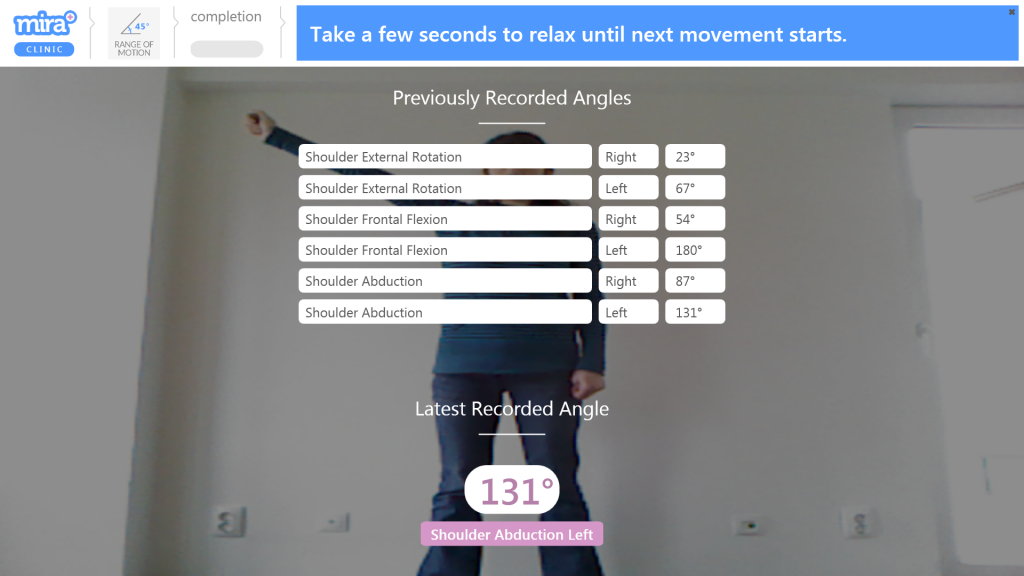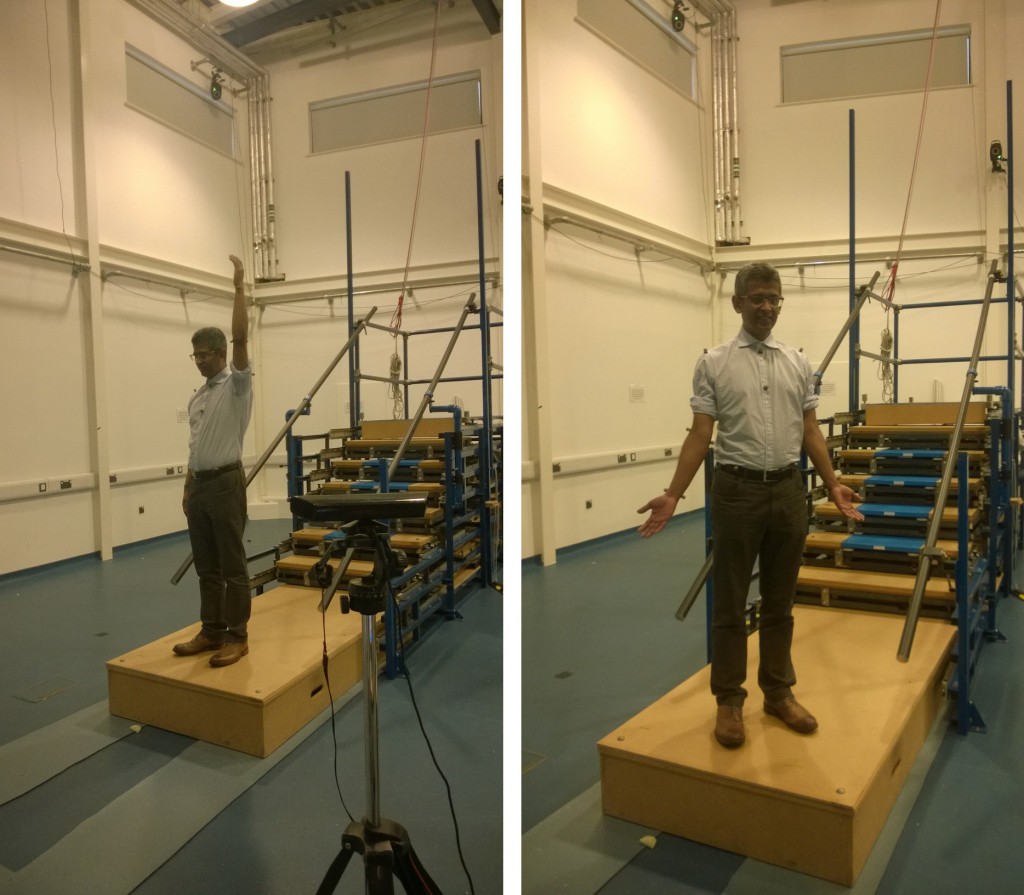The MIRA system is a software application with features that far surpass the gamification of physical rehabilitation. It is an innovative tool with features designed to offer therapists quantitative data on patient performance, measurement statistics and assessment information. Accurate and objective measurements of adherence, engagement time, repetitions performed, speed, acceleration and range of motion (ROM) are some of the examples of the automated tracking features that MIRA gathers. Collection and analysis of such information can easily be overlooked by a therapist due to time constraints, particularly when the patient is completing the exercises at home.
The following studies highlight the research done with the MIRA system in validating the MIRA game points, movement statistics and the ROM tool. The results of these studies highlight the reliability of MIRA as an automated software that is a validated tool to be used in patient assessment.
MIRA Game Points and Movement Specific Metrics Are Proved To Be Valid For Evaluation of Motor Function in Children with CP [1]
AIM The aim of the study is to develop a reliable and valid occupational therapy scoring system for the assessment of bilateral upper limb function and performance in children with cerebral palsy (CP) using MIRA interactive video games with the Kinect 360 XBox sensor.
METHOD 16 healthy children and 11 children diagnosed with cerebral palsy played 2 sessions of four MIRA games that generate three performance quantifiers: distance (m), average acceleration (m/s2) and score (game points). The games used in this study are Catch, Follow, Move and Grab, played each 2 minutes for each arm on medium difficulty and require significant coordination movements for gameplay interaction. Construct validity was assessed by comparing the MACS (Manual Ability Classification System) stage with the MIRA assessment using Pearson’s and Spearman’s correlation coefficients. Logistic regression with the presence of illness was performed in order to assess the ability of the MIRA testing to predict the presence of cerebral palsy.
RESULTS All of the three parameters (total distance, total average acceleration and total points) had good intraclass correlation coefficients (greater than 0.83). Internal consistency tested with the Cronbach alpha coefficient was high (0.97). The repeatability of the MIRA testing schedule, assessed by Bland Altman plots, revealed that more than 95% of the data plots were placed within the ±2 standard deviations from the mean difference between the two testing sessions for the total average acceleration, total distance and total points. All data plots for points in each of the 7 games were placed within the ±2 standard deviations from the mean difference between the two testing sessions, suggesting that this was the most reliable parameter of the three.
CONCLUSION The reliability and the validity tests performed suggest that the scoring of the MIRA testing schedule is a reliable and valid occupational therapy tool for the assessment of bilateral upper limb function and performance in children with cerebral palsy. However, the clinical significance of the differences between measurements is yet to be determined in a further study on a larger number of participants and using more game sessions/participant in order to minimize the impact of the learning effect.
Using MIRA as a Range of Motion (ROM) Measurement Tool with a Kinect Provides Measures That Are Significantly In Closer Correlation with Vicon MoCap (Gold Standard) Than the Trained Observer Measurement [2]
AIM Our aim was to test the accuracy of measuring shoulder range of movement (ROM) with a simple lap-top and sensor combination against full motion capture laboratory equipment (MoCap) and compare this with the accuracy of shoulder physiotherapists and shoulder surgeons measuring the same movements.
METHODS The Microsoft Kinect device is a 3D movement sensor normally used with an Xbox video game console. The sensor is the size of a TV remote control and is placed on a table, pointing at the user. Software allows this to be used with a normal computer to measure shoulder movements. (Medical Interactive Recovery Assistant (MIRA)).
Forty-nine healthy volunteers had infrared markers placed on their thorax and upper limbs to allow the Vicon Motion Capture facility to measure the four cardinal shoulder movements. Movements were simultaneously measured by trained observers and the MIRA device. Internal rotation was assessed with the shoulder abducted 90° and external rotation with the arm adducted.
MoCap measurements were defined as the gold standard. Visual estimation and MIRA measurements were compared against MoCap for agreement, using Bland-Altman methods.
RESULTS Overall, 1670 measurements were available for analysis. MIRA measurement of all cardinal shoulder movements were significantly more precise than trained observer measurements.
The limits of agreement were (95% confidence interval):
Forward Flexion MIRA +/- 11° (8.7-12.6); trained observer +/- 16° (14.6-17.6)
Abduction MIRA +/- 11° (8.7-12.8); trained observer +/- 15° (13.4-16.2)
External rotation MIRA +/- 10° (8.1-11.9); trained observer +/- 21° (18.7-22.6)
Internal rotation MIRA +/- 9° (7.2-10.4); trained observer +/- 18° (16.0-19.3)
CONCLUSIONS A lap-top combined with a Microsoft Kinect sensor, that can be easily set up in any home or office environment, can measure shoulder movements with acceptable levels of accuracy. This technology may allow precise shoulder ROM measurement, outside the clinic setting.
References
[1] Moldovan, I. M., Călin, A. D., Cantea, A. C., Dascălu, L. A., Mihaiu, C. A., Ghircău, O., Onac, S., Rîză, O.,Moldovan, R. A., Pop, L. V., Development of a new scoring system for bilateral upper limb function and performance in children with cerebral palsy using the MIRA interactive video games and the Kinect sensor, International Conference on Disability, Virtual Reality and Associated Technologies, 2-4 September 2014, Gothenburg, Sweden.
LINK: http://www.icdvrat.org/2014/papers/ICDVRAT2014_S07N2_Moldovan_etal.pdf
[2] JD Wilson, J Khan-Perez, D Marley, S Buttress, M Walton, L Baihua, Bibhas Roy, Can Shoulder Range Of Movement Be Measured Accurately Using New Technology?, BESS (British Elbow & Shoulder Society) 24 – 26 June 2015, Sheffield, UK.
LINK: http://sel.sagepub.com/content/7/4/309.extract




